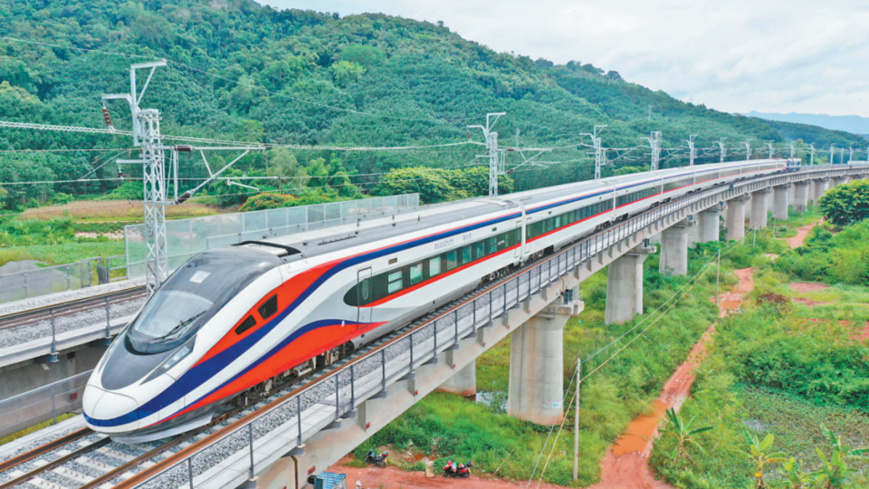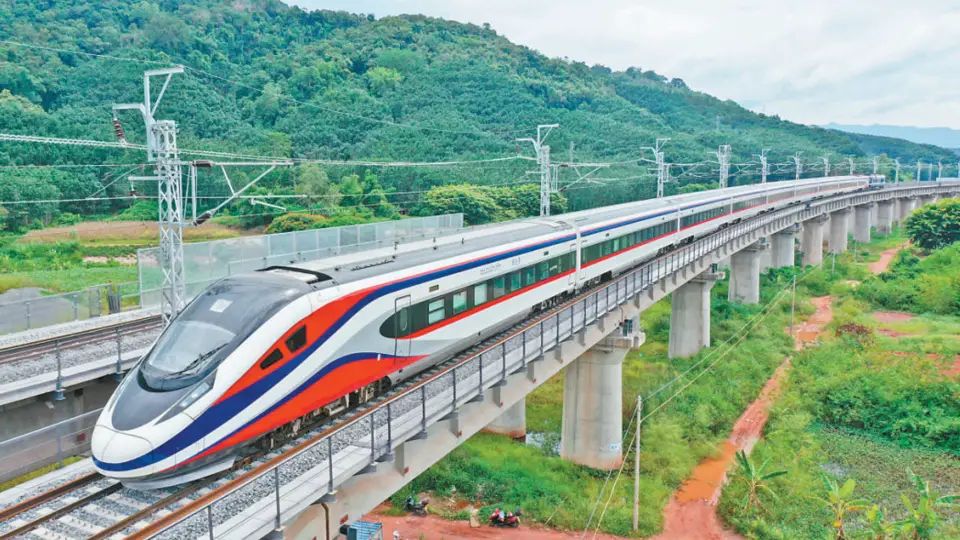By Jiang Zaidong

Lancang bullet train, the streamlined "China-standard" electric multiple unit train for the China-Laos Railway, heads for Vientiane. (Photo courtesy of China Railway International Group)
A transport artery carrying the development dreams of the Laotian people and the friendship between China and Laos has come true, as the China-Laos Railway officially started operation on Dec. 3.
Laos is a friendly neighbor of China, as well as the only landlocked country in Southeast Asia. As a mountainous country, Laos has only 3.5 kilometers of rail tracks, which has confined the country's economic development.
To break the transport bottleneck and realize the country's dreams of development, Laos has implemented a national strategy to convert itself from a landlocked country to a land-linked hub and is actively aligning this strategy with China's Belt and Road Initiative (BRI).
As a signature project of the co-construction of the BRI and one that demonstrates the China-Laos friendship, the China-Laos Railway connects Kunming, southwest China's Yunnan province, with the Laotian capital, Vientiane, and commenced in December 2016.
Leaders of both countries contributed to the construction of the railway. Chinese President Xi Jinping called for efforts to ensure the smooth progress in buildingthe China-Laos Railway and expand the radiation and demonstration effects of major projects such as the China-Laos railway. He has charted the course and provided a fundamental principle for the construction of the railway.
The two countries have established “fast tracks” for personnel exchanges and “green passages” for goods transportation to ensure the construction of the railway amid the COVID-19 pandemic.
The railway winds along terrains with complicated topographical and geological conditions. Sixty-two percent of the main tracks in Laos are paved on bridges and in tunnels. There are 10 tunnels stretching over five kilometers and 32 bridges with a span of more than 500 meters. Besides, the railway crosses the Mekong River twice. The constructors from China and Laos have overcome difficulties and finished the railway with high standards and quality, making the railway ready to be operational.
The opening of the railway has triggered broad attention across Laos. The recent delivery of the Lancang bullet train, the streamlined "China-standard" electric multiple unit train for the China-Laos Railway, made headlines in the country, and the news flooded Laotian social media. Members of the Laotian National Assembly posted photos of them experiencing the train on social media to show their support.
Meanwhile, the shortened traveling time between Kunming and Vientiane is also a hot topic on the Chinese internet, and the railway has ended the history when there was no rail track entering Xishuangbanna, a famous tourist destination in Yunnan.
The China-Laos Railway not only connects the two countries, but also reinforces the bond between the two peoples. It is a carrier of and mirrors the China-Laos community with a shared future.
In addition, the railway is also a road leading to development. It will better help China and Laos coordinate connectivity and capacity and investment cooperation, and advance the building of the China-Laos Economic Corridor. The two countries can make greater contributions to the high-quality construction of the BRI.
The huge impetus injected by the China-Laos Railway into regional connectivity and cooperation has drawn great attention from surrounding countries. For instance, the Thai Embassy in Laos has enquired about the schedule of the rail line, hoping to expand transport volume from Thailand to China and lower transport costs.
The China-Laos Railway is not only a key project of China-Laos cooperation, but also a key hub of the regional transport network. To make full use of its radiation and demonstration effects, all parties concerned will start working on connecting the China-Laos Railway to the Laos-Thailand Railway, so as to further connect the networks of the Singapore-Malaysia railway and the China-Europe Railway Express.
We believe that the China-Laos Railway is able to turn Laos from a landlocked country into a transport hub and make the country an accelerator for regional connectivity and a new engine driving economic cooperation. The railway will pave a road of development for Laos and other regional countries.
(Jiang Zaidong is the Chinese Ambassador to Laos.)
Laos is a friendly neighbor of China, as well as the only landlocked country in Southeast Asia. As a mountainous country, Laos has only 3.5 kilometers of rail tracks, which has confined the country's economic development.
To break the transport bottleneck and realize the country's dreams of development, Laos has implemented a national strategy to convert itself from a landlocked country to a land-linked hub and is actively aligning this strategy with China's Belt and Road Initiative (BRI).
As a signature project of the co-construction of the BRI and one that demonstrates the China-Laos friendship, the China-Laos Railway connects Kunming, southwest China's Yunnan province, with the Laotian capital, Vientiane, and commenced in December 2016.
Leaders of both countries contributed to the construction of the railway. Chinese President Xi Jinping called for efforts to ensure the smooth progress in buildingthe China-Laos Railway and expand the radiation and demonstration effects of major projects such as the China-Laos railway. He has charted the course and provided a fundamental principle for the construction of the railway.
The two countries have established “fast tracks” for personnel exchanges and “green passages” for goods transportation to ensure the construction of the railway amid the COVID-19 pandemic.
The railway winds along terrains with complicated topographical and geological conditions. Sixty-two percent of the main tracks in Laos are paved on bridges and in tunnels. There are 10 tunnels stretching over five kilometers and 32 bridges with a span of more than 500 meters. Besides, the railway crosses the Mekong River twice. The constructors from China and Laos have overcome difficulties and finished the railway with high standards and quality, making the railway ready to be operational.
The opening of the railway has triggered broad attention across Laos. The recent delivery of the Lancang bullet train, the streamlined "China-standard" electric multiple unit train for the China-Laos Railway, made headlines in the country, and the news flooded Laotian social media. Members of the Laotian National Assembly posted photos of them experiencing the train on social media to show their support.
Meanwhile, the shortened traveling time between Kunming and Vientiane is also a hot topic on the Chinese internet, and the railway has ended the history when there was no rail track entering Xishuangbanna, a famous tourist destination in Yunnan.
The China-Laos Railway not only connects the two countries, but also reinforces the bond between the two peoples. It is a carrier of and mirrors the China-Laos community with a shared future.
In addition, the railway is also a road leading to development. It will better help China and Laos coordinate connectivity and capacity and investment cooperation, and advance the building of the China-Laos Economic Corridor. The two countries can make greater contributions to the high-quality construction of the BRI.
The huge impetus injected by the China-Laos Railway into regional connectivity and cooperation has drawn great attention from surrounding countries. For instance, the Thai Embassy in Laos has enquired about the schedule of the rail line, hoping to expand transport volume from Thailand to China and lower transport costs.
The China-Laos Railway is not only a key project of China-Laos cooperation, but also a key hub of the regional transport network. To make full use of its radiation and demonstration effects, all parties concerned will start working on connecting the China-Laos Railway to the Laos-Thailand Railway, so as to further connect the networks of the Singapore-Malaysia railway and the China-Europe Railway Express.
We believe that the China-Laos Railway is able to turn Laos from a landlocked country into a transport hub and make the country an accelerator for regional connectivity and a new engine driving economic cooperation. The railway will pave a road of development for Laos and other regional countries.
(Jiang Zaidong is the Chinese Ambassador to Laos.)
 Menu
Menu
 China-Laos Railway a road of friendship that leads to prosperity
China-Laos Railway a road of friendship that leads to prosperity
















